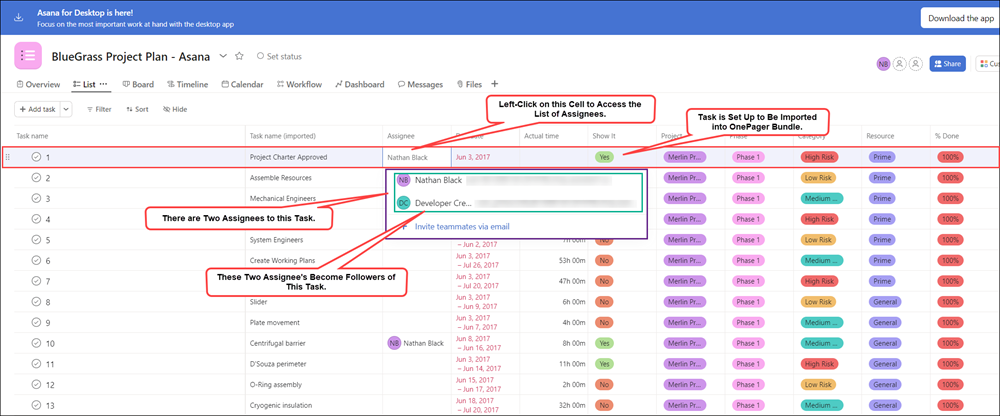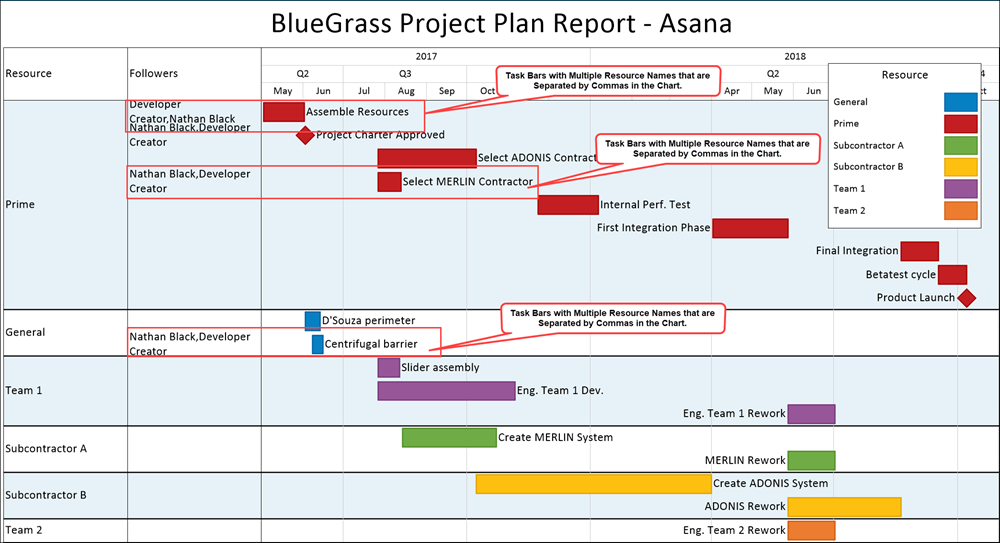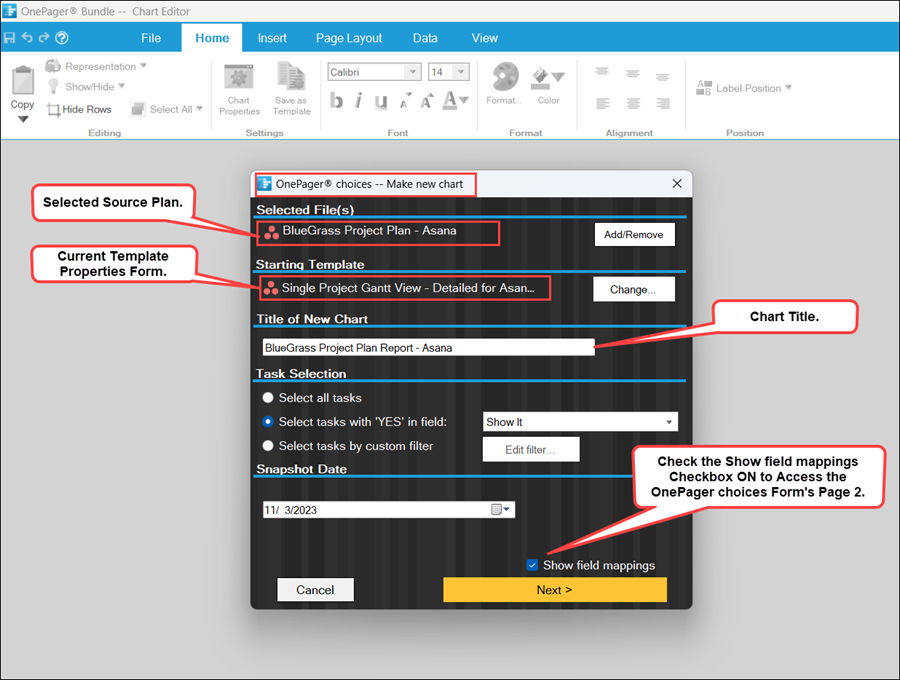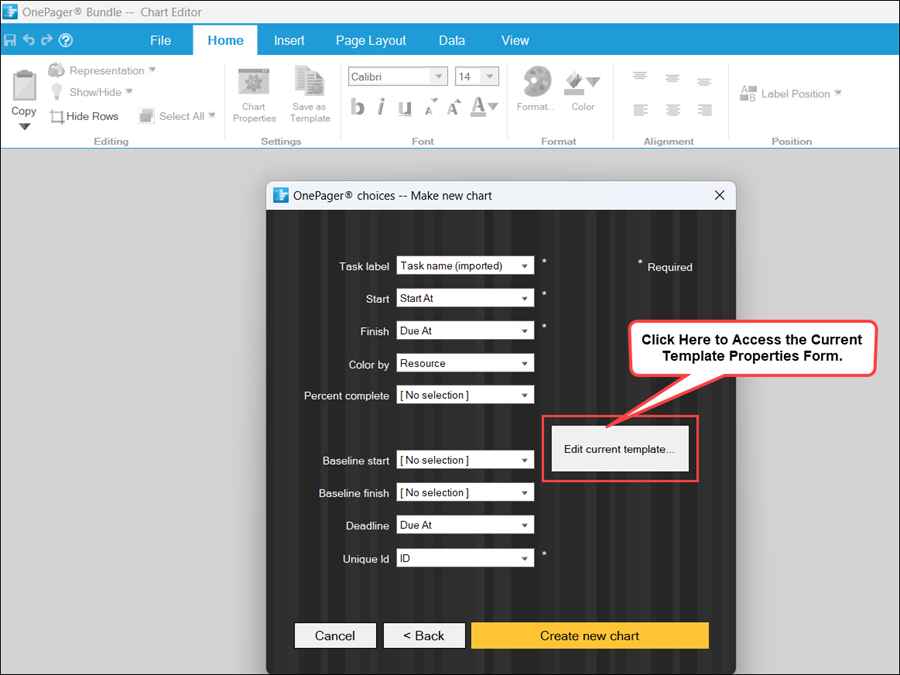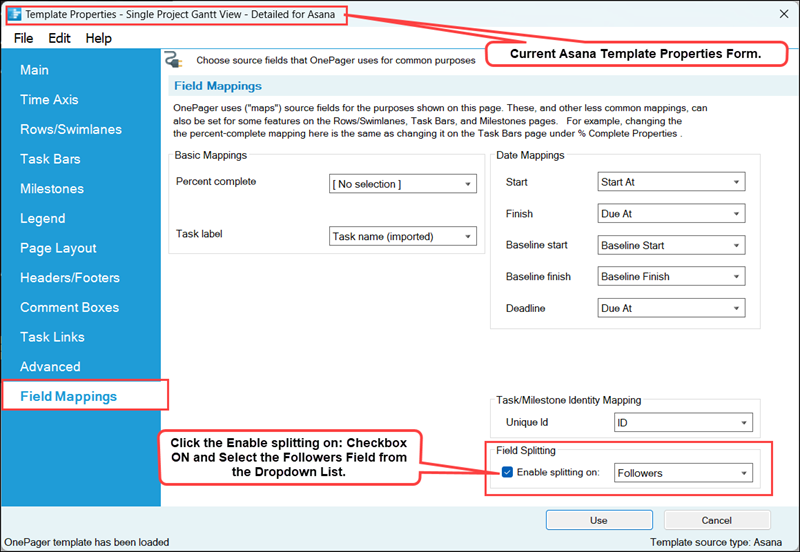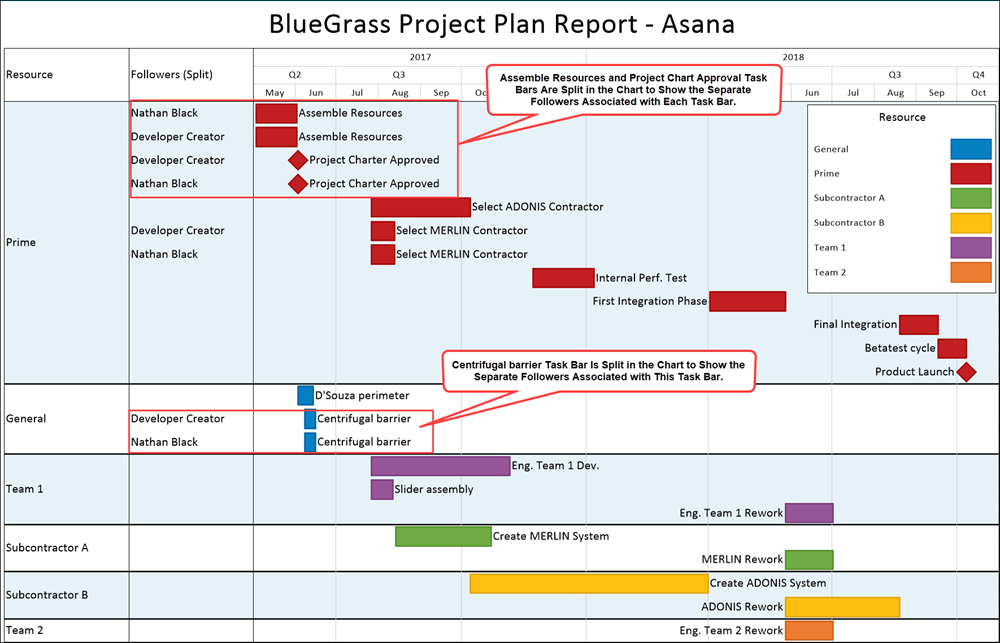|
|
| (516 intermediate revisions by 2 users not shown) |
| Line 1: |
Line 1: |
| − | ==Overview== | + | ==Introduction== |
| | | | |
| − | This article covers manual swimlane groupings, as opposed to the automatic, data-driven swimlanes that appear by default in OnePager charts. For more information on automatic '''swimlane groupings''', please see the article at: [[Creating, Formatting, and Sorting Swimlanes Levels for Version 7.0 | Creating, Formatting, and Sorting Swimlanes Levels]] <!--12.02.1-70--> | + | This article is focused on using the ''' Column Splitting''' feature with OnePager Bundle '''Standalone''' and '''imported''' Asana '''source plans'''. |
| | | | |
| − | In order to '''group rows into swimlanes''', at least two '''rows''' must be selected in the chart and at least one '''swimlane level '''must be '''defined''' for the chart. If only one '''row''' is selected, OnePager '''disables''' the '''Group rows into a swimlane '''command in the '''text column '''right-click '''context menu'''. Two or more '''rows''' may be '''grouped into swimlanes''' when one or more (all) '''swimlane levels''' are '''hidden'''. If these conditions are '''not met''', when the '''text column''' right-click '''context menu''' is accessed, the '''Group rows into a swimlane '''command is '''disabled''' as shown here:
| + | ==About Splitting and Parsing Fields== |
| | | | |
| − | <center>[[File:P70-12_16_1-(2A)-07282020.png]]</center>
| + | The OnePager '''column splitting''' feature allows you to '''duplicate task bars''' when a task in your Asana '''source plan''' is assigned to '''multiple resources''' (or anything else). Because assignments from Asana often are '''comma-delimited''', this feature enables OnePager to '''parse the comma-delimited list''' and '''create a unique task bar''' for each instance in the '''comma-separated''' list. |
| − | <!--<center>P70-12_16_1-(2A)-07282020.png</center>-->
| + | |
| | | | |
| − | Since you can configure OnePager charts with up to three '''swimlane levels''', how '''rows''' are '''grouped into a swimlane''' depends on the membership of the '''row''' in the '''swimlane levels''' defined in the chart.
| + | ===Split Resource Names Example=== |
| | | | |
| − | This article discusses the '''various possible configurations '''for selected '''rows''' and how the '''Group rows into a swimlane '''command produces a consistent result in terms of the configuration of the '''new grouped swimlane''', its resulting '''position''' in the chart, and the '''labels''' assigned to the '''new grouped swimlane levels cells'''.
| + | Say you want to use '''color-codes''' on task bars/milestone symbols based upon your Asana '''source plan’s Assigned to''' column as shown below: |
| | | | |
| − | Depending on the original configuration of the chart, the number of '''swimlane levels''' defined and '''showing''', the results of applying the '''Group rows into a swimlane '''command follows a consistent pattern discussed in this article.
| + | <center>[[File:P72-24_5_3-72-(1)-11022023.png]]</center> |
| | + | <center>P72-24_5_3-72-(1)-11022023.png</center> |
| | | | |
| − | As an example, we can start by illustrating the results from '''grouping two rows from the same Left#3 swimlane level '''in the sequence shown below.
| + | Some of the entries in the '''Assigned to''' column consist of multiple, '''comma-separated''' items and some tasks only used one '''resource'''. Without the '''column splitting''' feature, a chart '''created''' from these data and assigned task bar/milestone symbol '''colors''' based upon the '''Assigned to''' column looks like this: |
| | | | |
| − | :1) Start by selecting the top two '''rows''' in the illustration below where these selected two '''rows''' are members of all '''three defined and shown swimlane levels'''. | + | <center>[[File:P72-24_5_3-72-(5)-11272023.png]]</center> |
| | + | <center>P72-24_5_3-72-(5)-11272023.png</center> |
| | | | |
| − | :2) The '''text column''' right-click '''context menu''' is accessed, and the '''Group rows into a swimlane''' command is '''enabled''' as shown here:
| + | OnePager, in this case, treats the '''entire string''' as an individual '''Assigned to''' value. To provide more flexibility in displaying task bars that have '''multiple resources''' assigned, OnePager supports the concept of a '''column splitting'''. This feature recognizes '''comma-separated''' values in a '''designated column''' and '''creates a separate task bar''' for each of the '''comma-separated''' values. |
| | | | |
| − | <center>[[File:P70-12_18_1-(2)-07302020.png]]</center>
| + | ===Enabling Splitting=== |
| − | <!--<center>P70-12_18_1-(2)-07302020.png</center>-->
| + | |
| | | | |
| − | :3) When the '''Group rows into swimlane''' command is clicked the results are shown in the chart here:
| + | To use this feature requires turning '''ON''' the feature in the Asana '''Template Properties''' form you intend to use to make the chart. The setting must be turned '''ON''' before the chart is created so launch OnePager Bundle from the '''desktop icon''', click the '''NEW''' button on the '''OnePager Bundle Start''' form to access the '''OnePager choices''' form, '''select''' your Asana '''source plan''', and type in the chart's '''title''' as shown here: |
| | | | |
| − | <center>[[File:P70-12_18_1-(3-1)-08042020.png]]</center> | + | <center>[[File:P72-24_5_3-72-(2A)-11022023.png]]</center> |
| − | <!--<center>P70-12_18_1-(3-1)-08042020.png</center>-->
| + | <center>P72-24_5_3-72-(2A)-11022023.png</center> |
| | | | |
| − | The end result in the illustration above is the creation of a '''new Left#3 swimlane''' positioned below '''the original Left#3 swimlane '''with the '''new grouped swimlane''' having the '''label''' of the '''original Left#3 swimlane'''.
| + | When you click the '''Next>''' button at the bottom of the form, OnePager accesses the second page of the '''OnePager choices''' form shown below: |
| | | | |
| − | '''Rows''' are '''grouped into a swimlane''' at the '''lowest swimlane level'''. In the illustration above, the '''lowest swimlane level is Left#3'''. When there are two or more '''rows''' in the '''lowest swimlane level''' are selected and are member of '''higher level swimlane''', as shown in the above chart, the result of '''grouping rows into a swimlane''' applies only to the '''lowest level swimlane'''. As shown in the illustration above, these '''higher level swimlanes''' are not altered by the action taken to '''group rows into a swimlane at the lowest level swimlane'''. When these conditions are '''not met''', OnePager '''disables '''the '''Group rows into a swimlane''' command in the '''text column''' right-click '''context menu'''.
| + | <center>[[File:P72-24_5_3-72-(2AA)-11022023.png]]</center> |
| | + | <center>P72-24_5_3-72-(2AA)-11022023.png</center> |
| | | | |
| − | Multiple '''rows''' in different '''Left#3 swimlane level cells''' can be selected and the '''Group rows into a swimlane '''command used to create a '''new grouping'''.
| + | Clicking the '''Edit current template''' button accesses the current '''Template Properties''' form. Navigate to the '''Field Mappings''' tab on the form, check the '''Enable splitting on:''' checkbox to '''ON''' and (in this example) select the '''Assigned To''' column from the dropdown list provided. The results are shown here: |
| | | | |
| − | ==Grouping Rows into a Swimlane – One Swimlane Level Chart==
| + | <center>[[File:P72-24_5_3-72-(2AAA)-11022023.png]]</center> |
| | + | <center>P72-24_5_3-72-(2AAA)-11022023.png</center> |
| | | | |
| − | To better illustrate how the '''Group rows into a swimlane '''command operates in the multiple swimlane level environment we start with the situation where one '''swimlane level''' is '''defined''' and '''showing''' in the chart. In the sub-sections that follow, we start with the '''Left#1 swimlane level defined '''and '''showing''' as the simplest case and proceed step-wise to demonstrated OnePager’s '''Group rows into a swimlane''' when there are '''two and three swimlane levels defined''' and '''showing''' in the chart.
| + | Click the '''Save and use''' button to complete the process and close the current '''Template Properties''' form returning you to the second page of the '''OnePager choices''' form show above. |
| | | | |
| − | ===Grouping Rows into a Swimlane from the Same Left#1 Swimlane Level Cell=== | + | ===Split Resources in the Chart=== |
| | | | |
| − | '''Grouping rows into a swimlane''' can be illustrated in the '''one swimlane level''' chart shown here as our starting point: | + | Clicking the '''Create new chart''' button completes the process and creates the chart with the '''column splitting''' feature in use. The chart with '''splitting''' looks like this: |
| | | | |
| − | <center>[[File:P70-12_18_1-(4)-07312020.png]]</center> | + | <center>[[File:P72-24_5_3-72-(2)-11022023.png]]</center> |
| − | <!--<center>P70-12_18_1-(4)-07312020.png</center>-->
| + | <center>P72-24_5_3-72-(2)-11022023.png</center> |
| | | | |
| − | Suppose you’d like to take the '''four rows''' in the '''Startup swimlane''' and '''group''' them so that there are '''two Startup Left#1 swimlane level cells''' in the chart. To do this, select the '''two top rows''' in the '''Startup swimlane''' using the '''CTL+Left-Click''' method, right-click in one of the selected '''text column cells''' to access the '''text column''' right-click '''context menu, '''and prepare to click the '''Group rows into a swimlane '''command as shown below:
| + | In the chart with '''column splitting''' shown above, there are now several more task bars in the '''Chart Editor''' than there were before. The task bar for '''Plate Movement''' is now '''split into two (2) separate task bars''', one for each of the '''two resources assigned'''. The task bar for '''Centrifugal Barrier''' is now '''split into three (3) separate task bars''', one for each of the '''three resources''' that were assigned to this task in the Asana '''source plan'''. Each of the '''resources''' has a unique '''color''' assigned. Each of the '''resources''' appears by itself in the '''Legend'''. The '''Legend title''' shows the '''column name''' that is used for '''splitting the columns'''. |
| | | | |
| − | <center>[[File:P70-12_18_1-(5-1)-08042020.png]]</center>
| + | With this feature, you can use '''column splitting''' just like any other column by using the dropdowns in the '''Template Properties''' form or '''Chart Properties''' form to assign '''colors, highlight task bars and milestone symbols, and to define and label rows and swimlanes'''. |
| − | <!--<center>P70-12_18_1-(5-1)-08042020.png</center>-->
| + | |
| | | | |
| − | When the '''Group rows into a swimlane''' command is clicked, the two selected '''rows''' become a new '''Left#1 swimlane''' with '''Startup''' as its '''Left#1 swimlane level cell label''' '''positioned below''' the original '''Left#1 swimlane level cell label''' as shown here:
| + | ==Splitting Resources and Task Links== |
| | | | |
| − | <center>[[File:P70-12_18_1-(5)-07312020.png]]</center>
| + | When task bars with '''Data-Driven''' or manual '''Task Links''' are '''split''', the '''Task Links''' ('''Data-Driven''' and manual) are '''not shown'''. Further, the '''Task Links''' that are now '''hidden''' and '''do not''' have entries in the '''Where are My Links?''' form. |
| − | <!--<center>P70-12_18_1-(5)-07312020.png</center>-->
| + | |
| − | | + | |
| − | When selected '''rows''' are '''grouped into a swimlane''' within an existing '''swimlane level cell''', OnePager places the '''new grouped swimlane below''' the original '''swimlane level cell''' to draw attention to the '''new grouping'''. OnePager assumes that the reason for '''grouping rows into a swimlane''' is that, in most schedule presentation situations, the '''new grouped rows''' (now a '''swimlane '''on its own) will be '''re-positioned''' elsewhere in the chart and potentially the '''new grouped swimlane level cell label''' will be '''edited'''. As a result, you have the option to retain the '''new grouped rows''' in the OnePager designated '''position''' or move the '''new grouped swimlane '''using the '''drag and drop''' method to a different '''position''' in the chart. | + | |
| − | | + | |
| − | For more information on '''moving swimlanes''', please see the article at: [[Moving Swimlanes for Version 7.0 | Moving Swimlanes]] <!--12.10.1-70-->
| + | |
| − | | + | |
| − | Once the '''new swimlane''' is created containing the two selected '''rows''' shown above, the '''new swimlane''' can be '''edited''' the same as any other '''swimlane''' in the chart. '''Edits''' can include changing the '''label''' in the '''Left#1 swimlane level cell''', '''dragging and dropping''' the '''new swimlane''' to another '''position''' in the chart, or changing its '''background color''' in some fashion.
| + | |
| − | | + | |
| − | For more information on '''editing rows and swimlanes''' please see the two articles at: [[Editing Row Properties for Version 7.0 | Editing Row Properties]] <!--12.22.1-70--> and [[Editing Swimlane Properties for Version 7.0 | Editing Swimlane Properties]] <!--12.23.1-70-->
| + | |
| − | | + | |
| − | ===Grouping Rows into a Swimlane from Different Left#1 Swimlane Level Cells===
| + | |
| − | | + | |
| − | To illustrate what happens when '''rows''' are selected from '''different Left#1 swimlane level cells''', we again start with the original chart configuration shown below:
| + | |
| − | | + | |
| − | <center>[[File:P70-12_18_1-(4)-07312020.png]]</center>
| + | |
| − | <!--<center>P70-12_18_1-(4)-07312020.png</center>-->
| + | |
| − | | + | |
| − | For this example, lets select one '''row''' in the '''Startup Left#1 swimlane''' and three '''rows''' in the '''Phase III Left#1 swimlane''' as shown here:
| + | |
| − | | + | |
| − | <center>[[File:P70-12_18_1-(7)-08032020.png]]</center>
| + | |
| − | <!--<center>P70-12_18_1-(7)-08032020.png</center>-->
| + | |
| − | | + | |
| − | When the '''Group rows into a swimlane''' command is clicked, the four selected '''rows''' become a '''new Left#1 swimlane''' with '''Phase III''' as its '''Left#1 swimlane level cell label''' '''positioned below''' the bottom '''Left#1 swimlane level cell label''' as shown here:
| + | |
| − | | + | |
| − | <center>[[File:P70-12_18_1-(8)-08032020.png]]</center>
| + | |
| − | <!--<center>P70-12_18_1-(8)-08032020.png</center>-->
| + | |
| − | | + | |
| − | Comparing the original with the resulting chart after '''grouping the four selected rows into a swimlane''', shown above, illustrates how OnePager handles one '''swimlane level''' case where '''rows''' are selected from '''different swimlanes'''.
| + | |
| − | | + | |
| − | :* The '''new grouped rows '''are placed together in sequence from top to bottom order.
| + | |
| − | :* The '''new grouped swimlane''' is placed at the bottom of the chart.
| + | |
| − | :* The '''new grouped Left#1 swimlane cell’s label''' is taken as the '''modal value''' from the '''origin swimlane labels''' associated with the '''original''' selected '''rows'''.
| + | |
| − | :* In this case, one selected '''row '''came from the '''Startup Left#1 swimlane''' and three '''rows''' came from the '''Phase III Left#1 swimlane'''.
| + | |
| − | :* As '''Phase III''' is the '''modal swimlane cell label''', the '''new grouped Left#1 swimlane''' takes the '''Phase III swimlane cell label'''.
| + | |
| − | | + | |
| − | ==Grouping Rows into a Swimlane – Two Swimlane Level Chart==
| + | |
| − | | + | |
| − | In the sub-sections that follow, we add the '''Left#2 swimlane level''' to the already present '''Left#1 swimlane level'''. Adding the '''Left#2 swimlane level''' to the original chart gives us a chart with this configuration:
| + | |
| − | | + | |
| − | <center>[[File:P70-12_18_1-(9)-08032020.png]]</center>
| + | |
| − | <!--<center>P70-12_18_1-(9)-08032020.png</center>-->
| + | |
| − | | + | |
| − | ===Grouping Rows into a Swimlane from the Same Left#2 and Left#1 Swimlane Level Cells===
| + | |
| − | | + | |
| − | Selecting multiple '''rows''' from the '''same Left#2 and Left#1 swimlane level cell''' is the same as the example above for '''grouping rows into a swimlane from the same Left#1 swimlane level cell''' when there is no '''Left#2 swimlane level''' configured in the chart.
| + | |
| − | | + | |
| − | Because the results are the same, please refer back to the example at: [[Grouping Rows into Swimlanes for Version 7.0#Grouping Rows into a Swimlane from the Same Left#1 Swimlane Level Cell | Grouping Rows into a Swimlane from the Same Left#1 Swimlane Level Cell]] <!-- 12.18.1-70-->
| + | |
| − | | + | |
| − | ===Grouping Rows into a Swimlane from Different Left#2 and Left#1 Swimlane Level Cells===
| + | |
| − | | + | |
| − | There are two situations here to explore: (1) The first is where the '''Left#1 swimlane levels''' are the '''same''' but the '''Left#2 swimlane levels''' are '''different''' for the selected '''rows''' and (2) where the '''Left#1 swimlane levels''' may be the '''same''' or '''different''' and the selected '''rows''' are in '''different Left#2 swimlane levels'''. We’ll take each in turn.
| + | |
| − | | + | |
| − | ====Rows Selected from the Same Left#1 Swimlane Levels but Different Left#2 Swimlane Levels====
| + | |
| − | | + | |
| − | To illustrate this first situation, consider the five selected '''rows''' shown in the chart below:
| + | |
| − | | + | |
| − | <center>[[File:P70-12_18_1-(10)-08032020.png]]</center>
| + | |
| − | <!--<center>P70-12_18_1-(10)-08032020.png</center>-->
| + | |
| − | | + | |
| − | When the '''Group rows into a swimlane''' command is clicked, the chart is reconfigured as shown below:
| + | |
| − | | + | |
| − | <center>[[File:P70-12_18_1-(11)-08032020.png]]</center>
| + | |
| − | <!--<center>P70-12_18_1-(11)-08032020.png</center>-->
| + | |
| − | | + | |
| − | Comparing the original with the resulting chart after '''grouping the five selected rows into a swimlane''', shown above, illustrates how OnePager handles the two '''swimlane level''' case where '''rows''' are selected from '''different Left#2 swimlanes '''residing in the '''same Left#1 swimlane'''.
| + | |
| − | | + | |
| − | :* The '''new grouped rows''' are placed together in sequence from top to bottom order.
| + | |
| − | :* The '''new grouped swimlane''' is placed at the bottom of the involved '''Left#1 swimlane''' ('''Phase III'''), usually the bottom of the chart.
| + | |
| − | :* The '''new grouped Left#2 swimlane cell’s label''' is taken as the '''modal value''' from the '''origin Left#2 swimlane cell label''' associated with the '''original''' selected '''rows'''.
| + | |
| − | :* In this case, two selected '''row '''came from the '''Integration & Testing Left#2 swimlane''' and three '''rows''' came from the '''Refactoring & Deployment Left#2 swimlane'''.
| + | |
| − | :* As '''Refactoring & Deployment''' is the '''modal Left#2 swimlane cell’s label''', the '''new grouped Left#2 swimlane''' takes the '''Refactoring & Deployment swimlane cell label'''.
| + | |
| − | | + | |
| − | ====Rows Selected from Different Left#1 Swimlane Levels and Different Left#2 Swimlane Levels====
| + | |
| − | | + | |
| − | To consider this illustration carefully, let’s take a fresh look back at the original chart shown here:
| + | |
| − | | + | |
| − | <center>[[File:P70-12_18_1-(9)-08032020.png]]</center>
| + | |
| − | <!--<center>P70-12_18_1-(9)-08032020.png</center>-->
| + | |
| − | | + | |
| − | To illustrate the second situation, three '''rows''' are selected from the '''same Left#1 and Left#2 swimlanes''' and two '''rows''' are selected from '''different Left#1 and Left#2 swimlanes''' from the three '''rows''' selected at the top of the chart as shown below:
| + | |
| − | | + | |
| − | <center>[[File:P70-12_18_1-(12)-08032020.png]]</center>
| + | |
| − | <!--<center>P70-12_18_1-(12)-08032020.png</center>-->
| + | |
| − | | + | |
| − | The illustration remains valid even if the three '''rows''' selected at the top of the chart were selected from '''different Left#1 and Left#2 swimlanes'''. The illustration is meant to show the results from selecting '''rows''' in '''different Left#1 and Left#2 swimlanes'''.
| + | |
| − | | + | |
| − | When the '''Group rows into a swimlane '''command is clicked, the chart is reconfigured as shown below:
| + | |
| − | | + | |
| − | <center>[[File:P70-12_18_1-(13)-08032020.png]]</center>
| + | |
| − | <!--<center>P70-12_18_1-(13)-08032020.png</center>-->
| + | |
| − | | + | |
| − | Again, comparing the original with the resulting chart after '''grouping the five selected rows into a swimlane''', shown above, illustrates how OnePager handles the two '''swimlane level''' case where '''rows''' are selected from '''different Left#1 and Left#2 swimlanes'''.
| + | |
| − | | + | |
| − | :* The '''new grouped rows''' are placed together in sequence from top to bottom order.
| + | |
| − | :* The '''new grouped swimlane''' is placed at the bottom of the chart.
| + | |
| − | :* The '''new grouped Left#2 swimlane cell’s label''' is taken as the '''modal value''' from the '''origin Left#2 swimlane cell label''' associated with the '''original''' three selected '''rows'''.
| + | |
| − | :* The '''new grouped Left#1 swimlane cell’s label''' is taken as the '''modal value''' from the '''origin Left#1 swimlane cell label''' associated with the '''original''' three selected '''rows'''.
| + | |
| − | :* In this case, three selected '''row '''came from the '''Startup Left#1 swimlane '''and '''Planning Left#2 swimlane'''.
| + | |
| − | | + | |
| − | ==Grouping Rows into a Swimlane – Three Swimlane Level Chart==
| + | |
| − | | + | |
| − | In the sub-sections that follow, we add the '''Left#3 swimlane level''' to the already '''defined '''and '''showing''' '''Left#1 and Left#2 swimlane levels'''. Adding the '''Left#3 swimlane level''' to the original chart produces a chart with this configuration:
| + | |
| − | | + | |
| − | <center>[[File:P70-12_18_1-(14)-08032020.png]]</center>
| + | |
| − | <!--<center>P70-12_18_1-(14)-08032020.png</center>-->
| + | |
| − | | + | |
| − | If you’ve followed along through the discussions involving configurations of '''one''' and '''two swimlane levels''' in the chart, you can rightly suspect that the various combinations involving '''three swimlane levels''' with selected '''rows''' from the '''same or different swimlane levels''' follows a recurring pattern. Your suspicions are correct. So to reduce the number of possible examples, we’ll eliminate coverage of the situation where selected '''rows''' come from the same '''Left#1, Left#2, and Left#3 swimlanes'''.
| + | |
| − | | + | |
| − | In this sub-section we’ll cover only the case where '''three rows''' are selected from '''different Left#1, Left#2, and Left#3 swimlanes'''. In a chart with '''three swimlane levels''', the examples in the previous sub-sections (where we discussed selecting '''rows''' in a '''single swimlane level''' chart and a '''two swimlane level''' chart) applies to the '''three swimlane level''' chart where '''rows''' are selected from a '''single swimlane level''' or '''two different swimlane levels'''.
| + | |
| − | | + | |
| − | ====Rows Selected from Different Left#1, Left#2, and Left#3 Swimlane Levels ====
| + | |
| − | | + | |
| − | To illustrate the three '''swimlane level''' chart configuration, three '''rows''' are selected from the '''different Left#1, Left#2, and Left#3 swimlane levels''' as shown below:
| + | |
| − | | + | |
| − | <center>[[File:P70-12_18_1-(15)-08032020.png]]</center>
| + | |
| − | <!--<center>P70-12_18_1-(15)-08032020.png</center>-->
| + | |
| − | | + | |
| − | Please note that in the above chart there are '''no modal swimlane level cell labels'''. That is, there are an equal number of '''rows''' selected for each of the '''three different swimlane levels'''.
| + | |
| − | | + | |
| − | After clicking the '''Group rows into a swimlane '''command, the chart looks like this:
| + | |
| − | | + | |
| − | <center>[[File:P70-12_18_1-(16-1)-08042020.png]]</center>
| + | |
| − | <!--<center>P70-12_18_1-(16-1)-08042020.png</center>-->
| + | |
| − | | + | |
| − | For the example in this sub-section, comparing the original with the resulting chart after '''grouping the three selected rows into a swimlane''', shown above, illustrates how OnePager handles the three '''swimlane level''' case where '''rows''' are selected from '''different Left#1, Left#2 and Left#3 swimlane levels'''.
| + | |
| − | | + | |
| − | :* The '''new grouped rows''' are placed together in sequence from top to bottom order.
| + | |
| − | :* The '''new grouped swimlane '''is placed at the bottom of the chart.
| + | |
| − | :* Since only one '''row''' was selected in each combination of '''swimlane levels''', there are no '''modal Left#1''', '''Left#2''', and '''Left#3 swimlane level cell labels''' in the '''new grouping''' of three selected '''rows'''.
| + | |
| − | :* Under this condition, OnePager selects the '''labels''' for '''new grouped swimlane level cells''' at '''random''' for the three '''rows'''.
| + | |
| − | :* OnePager uses just the '''random '''selection of resulting '''swimlane level cell label''' in anticipation that you will most likely '''edit '''the''' three grouped level swimlane cell labels''' to meet your specific schedule presentation needs.
| + | |
| − | | + | |
| − | Regardless of the number of '''rows''' selected and used with the '''Group rows into a swimlane '''command, OnePager uses the '''random''' selection of '''grouped swimlane level cell’s labels''' to populate the corresponding '''new grouped swimlane level cell labels'''. In the illustration above, the '''random''' selection happened to be the three '''bottom most Left#1''', '''Left#2''', and '''Left#3 swimlane level cell labels'''.
| + | |
| | | | |
| | ==Related Links== | | ==Related Links== |
| | | | |
| − | [[Manual Editing Task/Milestone Shapes and Text Labels for Version 7.0 (Portal) | Manual Editing Task/Milestone Shapes and Text Labels (Portal)]] <!--9.0.1-70--> | + | {| class="wikitable" |
| | + | | [[Templates versus Charts for Version 7.2 | Templates versus Charts]] 4.0.1.3-72 |
| | + | | [[Linking Task and Milestones Using Manual and Data-Driven Task Links for Version 7.2 | Linking Task and Milestone Using Manual and Data-Driven Task Links (Portal)]] 19.0.1-72 |
| | + | |- |
| | + | | [[Editing with the Chart Properties form for Version 7.2 (Portal) | Editing with the Chart Properties form (Portal)]] 21.0.1-72 |
| | + | | [[Template Only Features for OnePager Pro for Version 7.2 | Template Only Features for OnePager Pro]] 24.1.1-72 |
| | + | |- |
| | + | | [[Template Only Features for OnePager Express for Version 7.2 | Template Only Features for OnePager Express]] 24.2.1-72 |
| | + | | [[Template Only Features for Primavera P6 Source Plans in OnePager Version 7.2 | Template Only Features for Primavera P6 Source Plans in OnePager]] 24.2.2-72 |
| | + | |- |
| | + | | [[Template Only Features for Smartsheet Source Plans in OnePager Version 7.2 | Template Only Features for Smartsheet Source Plans in OnePager]] 24.2.3-72 |
| | + | | [[Splitting and Parsing Columns for OnePager Pro for Version 7.2 | Splitting and Parsing Fields for OnePager Pro]] 24.4.1-72 |
| | + | |- |
| | + | | [[Splitting and Parsing Columns for OnePager Express for Version 7.2 | Splitting and Parsing Fields for OnePager Express]] 24.5.1-72 |
| | + | | [[Splitting and Parsing Columns for Primavera P6 Source Plans in OnePager Version 7.2 | Splitting and Parsing Columns for Primavera P6 Source Plans in OnePager]] 24.5.2-72 |
| | + | |- |
| | + | | [[Splitting and Parsing Columns for Smartsheet Source Plans in OnePager Version 7.2 | Splitting and Parsing Columns for Smartsheet Source Plans in OnePager]] 24.5.3-72 |
| | + | | [[Splitting and Parsing Columns for Project for the Web Source Plans for Version 7.2 | Splitting and Parsing Columns for Project for the Web Source Plans]] 24.5.5-72 |
| | + | |- |
| | + | | [[Splitting and Parsing Columns for Planisware Enterprise Source Plans for Version 7.2 | Splitting and Parsing Columns for Planisware Enterprise Source Plans]] 24.5.7-72 |
| | + | | [[Splitting and Parsing Columns for Wrike in OnePager Version 7.2 | Splitting and Parsing Columns for Wrike in OnePager]] 24.5.11-72 |
| | + | |} |
| | | | |
| − | [[Creating and Editing Rows and Swimlanes for Version 7.0 (Portal) | Creating and Editing Rows and Swimlanes (Portal)]] <!--12.0.1-70-->
| + | (24.5.9-72) |
| | | | |
| − | [[About OnePager's Rows and Swimlanes | About OnePager's Rows and Swimlanes]] <!--12.0.2-70--> | + | [[Category:Version 7.2]] |
| − | | + | [[Category:Editing the Chart]] |
| − | [[Collecting, Formatting, and Sorting Task/Milestones into Rows for Version 7.0 | Collecting, Formatting, and Sorting Task/Milestones into Rows]] <!--12.01.1-70-->
| + | [[Category:Task/Milestone Editing]] |
| − | | + | [[Category:Column Splitting]] |
| − | [[Creating, Formatting, and Sorting Swimlanes Levels for Version 7.0 | Creating, Formatting, and Sorting Swimlanes Levels]] <!--12.02.1-70-->
| + | |
| − | | + | |
| − | [[Creating and Formatting Text Columns for Version 7.0 | Creating and Formatting Text Columns]] <!--12.03.1-70-->
| + | |
| − | | + | |
| − | [[Row and Swimlane Borders for Version 7.0 | Row and Swimlane Borders]] <!--12.04.1-70-->
| + | |
| − | | + | |
| − | [[Editing Text Columns or Swimlane Labels for Version 7.0 | Editing Text Columns or Swimlane Labels]] <!--12.3.1-70--> | + | |
| − | | + | |
| − | [[Manually Hiding and Unhiding Swimlane Levels for Version 7.0 | Manually Hiding and Unhiding Swimlane Levels]] <!--12.5.1-70-->
| + | |
| − | | + | |
| − | [[Resizing the Width of Text Columns and Swimlanes for Version 7.0 | Resizing the Width of Text Columns and Swimlanes]] <!--12.8.1-70-->
| + | |
| − | | + | |
| − | [[Resizing the Height of Rows for Version 7.0 | Resizing the Height of Rows]] <!--12.11.1-70-->
| + | |
| − | | + | |
| − | [[Hiding and Unhiding Rows and Swimlanes for Version 7.0 | Hiding and Unhiding Rows and Swimlanes]] <!--12.13.1-70-->
| + | |
| − | | + | |
| − | [[Adding a Row or Swimlane for Version 7.0 | Adding a Row or Swimlane]] <!--12.16.1-70-->
| + | |
| − | | + | |
| − | [[Merging Swimlanes for Version 7.0 | Merging Swimlanes]] <!--12.21.1-70-->
| + | |
| − | | + | |
| − | [[Editing Row Properties for Version 7.0 | Editing Row Properties]] <!--12.22.1-70--> | + | |
| − | | + | |
| − | [[Editing Swimlane Properties for Version 7.0 | Editing Swimlane Properties]] <!--12.23.1-70-->
| + | |
| − | | + | |
| − | [[Zebra Striping for Rows and Swimlanes for OnePager Pro for Version 7.0 | Zebra Striping for Rows and Swimlanes for OnePager Pro]] <!--12.24.1-70-->
| + | |
| − | | + | |
| − | [[Zebra Striping for Rows and Swimlanes for OnePager Express for Version 7.0 | Zebra Striping for Rows and Swimlanes for OnePager Express]] <!--12.24.2-70-->
| + | |
| − | | + | |
| − | [[Editing with the Chart Properties form for Version 7.0 (Portal) | Editing with the Chart Properties form (Portal)]] <!--21.0.1-70-->
| + | |
| − | | + | |
| − | [[Managing Templates for Version 7.0 (Portal) | Managing Templates (Portal)]] <!--24.0.1-70-->
| + | |
| − | | + | |
| − | (12.18.1-70)
| + | |
| − | | + | |
| − | [[Category:Version 7.0]] | + | |
| | [[Category:Charts]] | | [[Category:Charts]] |
| − | [[Category:Templates]] | + | [[Category:Task Links]] |
| | + | [[Category:Ribbon]] |
| | + | [[Category:Snapshots]] |
| | + | [[Category:Template Properties Form]] |
| | [[Category:Chart Properties Form]] | | [[Category:Chart Properties Form]] |
| − | [[Category:Editing the Chart]] | + | [[Category:Asana]] |
| − | [[Category:Rows and Swimlanes]]
| + | [[Category:OnePager Bundle]] |
| − | [[Category:Multiple Swimlane Levels]]
| + | |
| − | [[Category:Labels]]
| + | |
| − | [[Category:Text Columns]]
| + | |
| − | [[Category:Snapshots]]
| + | |
| − | [[Category:Swimlane Stripes]]
| + | |
| − | [[Category:Mavericks]]
| + | |
| − | [[Category:OnePager Pro]]
| + | |
| − | [[Category:OnePager Express]] | + | |
